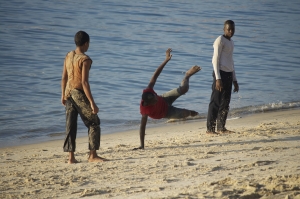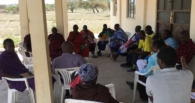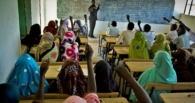Growing Young Gracefully
Making development work for Tanzania’s youth
Fran Girling
21 March 2016
/
- 0 Comments
The last year saw Mokoro spend a good deal of time in Tanzania. There were various aid portfolios, donor country strategies, budget support programmes and nutrition interventions to evaluate, as the Tanzanian government strives to realise its Development Vision and become a Middle Income Country by 2025.
At their January 2016 Quarterly Meeting Mokorons reflected on the development progress made by Tanzania and shared professional and personal experiences of the country. They spoke of the strong positive gains made in economic growth and national capacity, but also noted that the country, independent for over 50 years, still sees so many of its citizens living in poverty, with only a small minority enjoying the benefits of Tanzania’s impressive economic performance. This article will consider Tanzania’s current context and focus on one of its most important demographic trends: its increasingly youthful population. It will consider a nation making considerable economic and technological gains, with a growing proportion of young people at significant risk due to their position in society.

Since the union between Zanzibar and mainland Tanganyika in 1964, Tanzania has experienced uneven economic and political development. The country’s post-colonial history is marked by a relative stability for which it has gained a reputation as a safe haven not only with neighbouring populations affected by political violence, but also with donors and development practitioners. But despite the principles of self-reliance enshrined in Nyerere’s 1967 Arusha Declaration, Tanzania’s aid landscape remains one of heavy dependence, with Tanzania ranking in the top ten highest ODA recipient countries globally (OECD 2014) with net ODA contributing to over 40% of central government expenditure in 2014. This has been accompanied by substantial economic change: growth averaging 7% annually and GDP per capita rising from $172 in 1990 to $998 in 2014 (UNDP 2014). The past decade has seen Tanzania enjoy greater macroeconomic stability, lower inflation rates and a more liberalised and regionally integrated economy, with a GDP share increasingly bent toward industry rather than agriculture.
Yet economic growth has not achieved a significant decline in the prevalence of poverty, with one third of rural Tanzanians living below the poverty line. The country faces considerable challenges in achieving equitable economic distribution and inclusive growth. With structural changes in GDP share towards industrial sectors, high growth rates have been concentrated in sectors of low employment generation and 80 percent of Tanzanians still work in the agriculture sector. On top of this is a burgeoning informal labour market, with 79% of employment in the service sector on an informal basis. Developmental challenges are exacerbated by an expanding population, urbanisation and growing urban-rural disparities. Economic growth alone is clearly not enough to afford the majority of Tanzanians they kind of life they value, and in 2014 Tanzania even fell seven positions in the Human Development Index (UNDP 2014). The past decade has also seen growing concern about the standard of governance in Tanzania and the prevalence of corruption at the highest levels.
A demographic dividend?
Tanzania’s population is growing ever more youthful and, with 1.2 million births a year, two thirds of the population of 53 million are under 25 (TDHS 2010). At 2.7%, Tanzania has one of the fastest population growth rates in the world (UNDP 2014), demonstrating a so-called ‘youth bulge’ – a peak in the proportion of persons aged 15-24 in a population. The world as a whole reached this demographic milestone in the 1980s, yet for less developed countries the implications are just starting to be felt. Many argue that investing in the young is therefore an economically pragmatic as well as a socially positive move– with the right investment, countries experiencing a youth bulge can reap a ‘demographic dividend’ provided their young people are educated, healthy and gainfully employed (ODI 2013). This window of opportunity arguably accounted for the rapid growth witnessed in the Asian Tiger economies from the 1960s to the 1990s; a one-off phenomenon that requires urgent, targeted action in post-primary education, labour and livelihoods, civic engagement and sexual and reproductive health (Bloom 2003).
The fact that youth investment has higher absolute ‘returns’ than investment in older adults doesn’t seem surprising, and is reinforced by the kind of research that shows that every dollar of investment in education generates between 15 and 20 dollars of economic growth premium over an average working lifetime of 20 years (UNESCO 2012). La Cava et al. (2004) argue that the cost of not investing in youth inclusion is high, with youth marginalisation leading to increased levels of vulnerability and disruption. Furthermore, they argue for an inclusion approach through an empowerment lens, emphasising the need not only to develop the right environment for youth, but also to recognise the agency of youth in bringing about positive change.
Work to be done…
There is much to be done if Tanzania is to convert its youth bulge potential into a long-term developmental dividend. Despite economic growth, Tanzania ranks 134 out of 170 countries on the Youth Development Index (2013),[1] and while young people today are more likely to be literate than their parents, they are also less likely to be employed, particularly in the formal sector. Indeed, Tanzania’s youth are woefully under-occupied; in 2012 Tanzania had more unemployed 15-24 years olds per capita than 109 other countries with unemployed young women outnumbering their male peers by 33% (Restless Development 2013). A youth in Dar es Salaam is six times more likely to be ‘unemployed’ than a youth in a rural context, despite the ‘urban advantage’ often assumed by policy makers (UNICEF 2012). While development indicators are high for universal primary education, only 2% of young adults continue education at the tertiary level, as opposed to 8% in South Africa.
The Government of Tanzania’s National Five Year Development Plan (2012) seeks to “promote meaningful youth involvement and participation in politics to enhance good governance and acceptance”, including through the establishment of a National Youth Council. In 2007 the government hurriedly unveiled an ambitious National Youth Development Policy which promises “a mechanism to facilitate effective participation of youth”. Yet this mechanism has not been defined and the youth council has yet to materialise. Moreover, in 2012-13 the Youth Development Division, which is housed in the Ministry of Information, Culture, Youth and Sports, was allocated just 0.01% of the national budget. Considering that Tanzania’s definition of ‘youth’ stretches from age 15 to 35 (in contrast to the age range used by UNFPA of 10-24) this would seem paltry and short-sighted.
Broadband and Bulldozers
A particular feature of Tanzania’s youth is the increase in their technology use and competency. An example of this is the accelerated growth of mobile money (MM) over the past five years, with Tanzania now the second largest MM market in the world (after Kenya). MM is growing in market competitiveness as well as popularity among people traditionally excluded from the formal financial systems, such as youth, women and the rural poor. Between 2008 and 2013, the proportion of the population with access to mobile financial services grew from 1 percent to 90 percent, and in 2014 over half the population used MM services to send and receive remittances (GSMA 2014). With mobile phone and internet coverage services constantly expanding, opportunities to access formal bank products continue to increase. The growth in demand for digital payment systems is opening up employment opportunities for young people as ‘wakalas’, the agents who convert cash into electronic value for a small commission.
Innovative apps are also springing up to plug a hole in unfulfilled social services, such as what3words, a universal addressing system enabling those living in Dar es Salaam’s growing informal settlements to access services by registering a formal address, and OurCries, a digital platform for young people to report acts of assault. The OurCries app was created by 15-year old Modesta Joseph who addressed the need to safely and proactively combat the abuse experienced by many young urban Tanzanians as they use public transport (daladalas) to go to school. Reports are forwarded to the Surface and Marine Transport Regulatory Authority (SUMATRA) and the police who are able to take action. Modesta was part of the Apps and Girls Coding Club at her secondary school, an initiative designed to specifically break the gender gap in ICT. Another initiative that seeks to engage and equip youthful would-be entrepreneurs is the TANZICT project. TANZICT is supported by the Finnish Ministry of Foreign Affairs and provides grants to students and graduates to develop ICT-based business ideas. The project works with universities, municipalities and the private sector through capacity building and mentoring to develop and facilitate innovations based on the needs of the community. Apps created on a recent Buni Innovation Hub internship programme include a web application to visualise public data more readably, a Tanzanian football league scoring app and KilimoInfo – an agricultural app for farmers which includes information from the weather and soil varieties, to crop production cycles and pest control. TANZICT also aims to revise the National ICT Policy and strengthen the capacity of the Ministry of Communications, Science and Technology.
The increased use of social media to galvanise and facilitate youth political participation also played an important role in the Tanzanian presidential election last October. With an estimated five million first-time voters, the election was widely reported to have hinged on the youth vote. A USAID survey suggested that up to 92% of young mainlanders planned to vote, a significant increase from the previous election. Many viewed the victory of former Works Minister John Magufuli (of the dominant Chama Cha Mapinduzi party) over former Prime Minster Edward Lowassa as heralding a move toward a more transparent and accountable style of governance and a marked desire to return to the founding principles of Nyerere, also known for his modest lifestyle. Recent statistics scored Tanzania 117 out of 168 on the Transparency International perceptions index (2015), a figure Magufuli seems bent on changing. Indeed, Magufuli’s no-nonsense approach to corruption and time wasting has earned him the nickname ‘the Bulldozer’ and his penchant for money-saving measures, which have included drastically cutting the state dinner budget, cancelling costly Independence Day celebrations and vetoing first class government travel, caused the hashtag #WhatWouldMagufuliDo to trend for weeks.
Looking forward
A recent mobile phone survey by Tanzanian NGO TWAWEZA found that seven out of ten people in Tanzania were optimistic about their futures. Such (youthful?) optimism needs to be harnessed in order to capitalise on any kind of demographic dividend, through building on accountable systems of governance that provide equal access to basic services and employment opportunities. Tanzania has shown that economic growth alone is not enough when it comes to equitable poverty reduction across all demographics. A more encompassing change is needed that looks beyond economic statistics to the processes of wealth distribution and power relations that create and reinforce social exclusion, particularly for young people. Robust implementation frameworks need to translate progressive policies into real change and entrenched mechanisms for youth participation need to be applied to development policies to safeguard discussion around how young people are renegotiating their generational position in Tanzania’s changing context, avoiding the dilemma of being the ‘absent presence’ (Huijsmans et al., 2014).
One hundred days into Magufuli’s presidency political challenges remain, including continuing controversy around the annulment and re-run of the 2015 Zanzibar elections. Yet the positive momentum from last October appears to continue. Mokoro watches with interest how Magufuli’s drive for reform will unfold, and whether economic gains can translate into meaningful participation, employment generation and livelihood security for Tanzania’s young people.
[1] The Youth Development Index measures the status of 15-29 year-olds in 170 countries according to five key domains: Education, Health and Well-being, Employment, Civic Participation and Political Participation. YDI scores range from 0-1, 0 being the lowest youth development and 1 the highest.
Recent Mokoro assignments in Tanzania
- Evaluation of the World Food Programme’s country portfolio in Tanzania
- Evaluation of Finland’s country strategy modality in Tanzania
- Independent Comprehensive Evaluation of the Scaling Up Nutrition Programme – Tanzania country case study
- Joint evaluation of the REACH Initiative – Tanzania country case study
- Appraisal of Danida’s general budget support to Tanzania
Further reading/references
Bloom, D., Canning, D., Sevilla, J. (2003). The Demographic Dividend: A New Perspective on the Economic
Consequences of Population Change. RAND.
Castri, S. and Gidvani, L. (2014). Enabling mobile money policies in Tanzania. GSMA.
Huijsmans, R. George, S., Gigengack, R. and Sandra J T M Evers, S.J.T.M (2014).Theorising age and Generation in
Development: A relational approach. European Journal of Development Research 26.
La Cava, G., Clert, C., and Lytle, P. (2014). Investing in Youth Empowerment and Inclusion: A Social Development
Approach. World Bank.
Pereznieto, P., Harding, J. H. (2013). Investing in Youth in International Development Policy. ODI, London.
Restless Development (2013). Report on the State of Youth in Tanzania Today.
UNDP (2014).Tanzania Human Development Report: Economic Transformation for Economic Development.
UNICEF (2012). Cities and Children: The Challenge of Urbanisation in Tanzania.
You must be logged in to post a comment.



